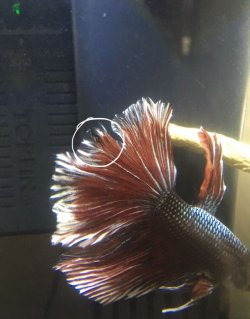Annemarie
Fish Fanatic
- Joined
- Jan 6, 2019
- Messages
- 63
- Reaction score
- 2
Hello! So I went away for a while on a trip and while I was gone my sister seems to have forgotten that fish aren’t just toys and completely avoided doing any water changes. I did a major one immediately once I got home (3 gallon tank with nerite snail) and noticed some black on his fins. Now the tips of his fins are normally white so it especially stood out. On one part it didn’t look too bad but on the other it looked decently obvious.
I’m nearly 100% sure it’s fin rot and aside from planning to do a minimum of 50% water changes daily for however long it takes, I need to know if it needs treatment. It looks to be moderately bad, so I think using aquarium salt would be sufficient. I have a good idea of how to use it but before I start, I want to know about it’s impact. Since nerite snails come from salty water (I think) can I still use the salt in this tank without having to remove him? I don’t currently have any other tanks so I’m not sure what I would do if I had to use aquarium salt and he couldn’t be in there.
Please let me know how to proceed from here. Thanks!
I’m nearly 100% sure it’s fin rot and aside from planning to do a minimum of 50% water changes daily for however long it takes, I need to know if it needs treatment. It looks to be moderately bad, so I think using aquarium salt would be sufficient. I have a good idea of how to use it but before I start, I want to know about it’s impact. Since nerite snails come from salty water (I think) can I still use the salt in this tank without having to remove him? I don’t currently have any other tanks so I’m not sure what I would do if I had to use aquarium salt and he couldn’t be in there.
Please let me know how to proceed from here. Thanks!




